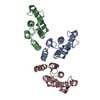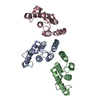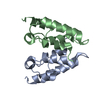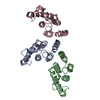[English] 日本語
 Yorodumi
Yorodumi- PDB-8puf: Structure of immature HTLV-1 CA-NTD from in vitro assembled MA126... -
+ Open data
Open data
- Basic information
Basic information
| Entry | Database: PDB / ID: 8puf | |||||||||||||||
|---|---|---|---|---|---|---|---|---|---|---|---|---|---|---|---|---|
| Title | Structure of immature HTLV-1 CA-NTD from in vitro assembled MA126-CANC tubes: axis angle 20 degrees | |||||||||||||||
 Components Components | Gag protein (Fragment) | |||||||||||||||
 Keywords Keywords |  VIRAL PROTEIN / VIRAL PROTEIN /  Retrovirus / Retrovirus /  HTLV / immature capsid / CA / CA-NTD HTLV / immature capsid / CA / CA-NTD | |||||||||||||||
| Function / homology |  Function and homology information Function and homology information | |||||||||||||||
| Biological species |   Human T-cell leukemia virus type I Human T-cell leukemia virus type I | |||||||||||||||
| Method |  ELECTRON MICROSCOPY / subtomogram averaging / ELECTRON MICROSCOPY / subtomogram averaging /  cryo EM / Resolution: 6.1 Å cryo EM / Resolution: 6.1 Å | |||||||||||||||
 Authors Authors | Obr, M. / Percipalle, M. / Chernikova, D. / Yang, H. / Thader, A. / Pinke, G. / Porley, D. / Mansky, L.M. / Dick, R.A. / Schur, F.K.M. | |||||||||||||||
| Funding support |  Austria, Austria,  United States, 4items United States, 4items
| |||||||||||||||
 Citation Citation |  Journal: bioRxiv / Year: 2023 Journal: bioRxiv / Year: 2023Title: Unconventional stabilization of the human T-cell leukemia virus type 1 immature Gag lattice. Authors: Martin Obr / Mathias Percipalle / Darya Chernikova / Huixin Yang / Andreas Thader / Gergely Pinke / Dario Porley / Louis M Mansky / Robert A Dick / Florian Km Schur /   Abstract: Human T-cell leukemia virus type 1 (HTLV-1) has an atypical immature particle morphology compared to other retroviruses. This indicates that these particles are formed in a way that is unique. Here ...Human T-cell leukemia virus type 1 (HTLV-1) has an atypical immature particle morphology compared to other retroviruses. This indicates that these particles are formed in a way that is unique. Here we report the results of cryo-electron tomography (cryo-ET) studies of HTLV-1 virus-like particles (VLPs) assembled , as well as derived from cells. This work shows that HTLV-1 employs an unconventional mechanism of Gag-Gag interactions to form the immature viral lattice. Analysis of high-resolution structural information from immature CA tubular arrays reveals that the primary stabilizing component in HTLV-1 is CA-NTD. Mutagenesis and biophysical analysis support this observation. This distinguishes HTLV-1 from other retroviruses, in which the stabilization is provided primarily by the CA-CTD. These results are the first to provide structural details of the quaternary arrangement of Gag for an immature deltaretrovirus, and this helps explain why HTLV-1 particles are morphologically distinct. | |||||||||||||||
| History |
|
- Structure visualization
Structure visualization
| Structure viewer | Molecule:  Molmil Molmil Jmol/JSmol Jmol/JSmol |
|---|
- Downloads & links
Downloads & links
- Download
Download
| PDBx/mmCIF format |  8puf.cif.gz 8puf.cif.gz | 53 KB | Display |  PDBx/mmCIF format PDBx/mmCIF format |
|---|---|---|---|---|
| PDB format |  pdb8puf.ent.gz pdb8puf.ent.gz | 28.2 KB | Display |  PDB format PDB format |
| PDBx/mmJSON format |  8puf.json.gz 8puf.json.gz | Tree view |  PDBx/mmJSON format PDBx/mmJSON format | |
| Others |  Other downloads Other downloads |
-Validation report
| Arichive directory |  https://data.pdbj.org/pub/pdb/validation_reports/pu/8puf https://data.pdbj.org/pub/pdb/validation_reports/pu/8puf ftp://data.pdbj.org/pub/pdb/validation_reports/pu/8puf ftp://data.pdbj.org/pub/pdb/validation_reports/pu/8puf | HTTPS FTP |
|---|
-Related structure data
| Related structure data |  17940MC  8pu6C  8pu7C  8pu8C  8pu9C  8puaC  8pubC  8pucC  8pudC  8pueC  8pugC  8puhC C: citing same article ( M: map data used to model this data |
|---|---|
| Similar structure data | Similarity search - Function & homology  F&H Search F&H Search |
- Links
Links
- Assembly
Assembly
| Deposited unit | 
|
|---|---|
| 1 |
|
- Components
Components
| #1: Protein | Mass: 13969.809 Da / Num. of mol.: 3 Source method: isolated from a genetically manipulated source Source: (gene. exp.)   Human T-cell leukemia virus type I / Production host: Human T-cell leukemia virus type I / Production host:   Escherichia coli BL21(DE3) (bacteria) / References: UniProt: X5GX59 Escherichia coli BL21(DE3) (bacteria) / References: UniProt: X5GX59 |
|---|
-Experimental details
-Experiment
| Experiment | Method:  ELECTRON MICROSCOPY ELECTRON MICROSCOPY |
|---|---|
| EM experiment | Aggregation state: HELICAL ARRAY / 3D reconstruction method: subtomogram averaging |
- Sample preparation
Sample preparation
| Component | Name: Human T-cell leukemia virus type I / Type: VIRUS / Entity ID: all / Source: RECOMBINANT | |||||||||||||||||||||||||
|---|---|---|---|---|---|---|---|---|---|---|---|---|---|---|---|---|---|---|---|---|---|---|---|---|---|---|
| Source (natural) | Organism:   Human T-cell leukemia virus type I Human T-cell leukemia virus type I | |||||||||||||||||||||||||
| Source (recombinant) | Organism:   Escherichia coli (E. coli) / Strain: BL21 (DE3) Escherichia coli (E. coli) / Strain: BL21 (DE3) | |||||||||||||||||||||||||
| Details of virus | Empty: YES / Enveloped: NO / Isolate: STRAIN / Type: VIRUS-LIKE PARTICLE | |||||||||||||||||||||||||
| Buffer solution | pH: 8 | |||||||||||||||||||||||||
| Buffer component |
| |||||||||||||||||||||||||
| Specimen | Embedding applied: NO / Shadowing applied: NO / Staining applied : NO / Vitrification applied : NO / Vitrification applied : YES : YES | |||||||||||||||||||||||||
| Specimen support | Grid material: COPPER / Grid mesh size: 300 divisions/in. / Grid type: C-flat-2/2 | |||||||||||||||||||||||||
Vitrification | Instrument: LEICA EM GP / Cryogen name: ETHANE / Humidity: 95 % / Chamber temperature: 283 K / Details: Grids coated with 2nm continuous carbon layer |
- Electron microscopy imaging
Electron microscopy imaging
| Experimental equipment |  Model: Titan Krios / Image courtesy: FEI Company | |||||||||||||||||||||
|---|---|---|---|---|---|---|---|---|---|---|---|---|---|---|---|---|---|---|---|---|---|---|
| EM imaging | Accelerating voltage: 300 kV / Alignment procedure: COMA FREE / Cryogen: NITROGEN / Electron source
| |||||||||||||||||||||
| Image recording |
| |||||||||||||||||||||
| EM imaging optics |
| |||||||||||||||||||||
| Image scans |
|
- Processing
Processing
| EM software |
| ||||||||||||||||||||||||||||||||||||||||||||||||||||||||||||||||||||||||
|---|---|---|---|---|---|---|---|---|---|---|---|---|---|---|---|---|---|---|---|---|---|---|---|---|---|---|---|---|---|---|---|---|---|---|---|---|---|---|---|---|---|---|---|---|---|---|---|---|---|---|---|---|---|---|---|---|---|---|---|---|---|---|---|---|---|---|---|---|---|---|---|---|---|
| Image processing | Details: Datasets (1) and (2) combined during Multiparticle refinement. See Materials and methods for details. | ||||||||||||||||||||||||||||||||||||||||||||||||||||||||||||||||||||||||
CTF correction | Type: PHASE FLIPPING AND AMPLITUDE CORRECTION | ||||||||||||||||||||||||||||||||||||||||||||||||||||||||||||||||||||||||
| Symmetry | Point symmetry : C2 (2 fold cyclic : C2 (2 fold cyclic ) ) | ||||||||||||||||||||||||||||||||||||||||||||||||||||||||||||||||||||||||
3D reconstruction | Resolution: 6.1 Å / Resolution method: FSC 0.143 CUT-OFF / Num. of particles: 7700 / Algorithm: BACK PROJECTION / Symmetry type: POINT | ||||||||||||||||||||||||||||||||||||||||||||||||||||||||||||||||||||||||
| EM volume selection | Num. of tomograms: 69 / Num. of volumes extracted: 245000 | ||||||||||||||||||||||||||||||||||||||||||||||||||||||||||||||||||||||||
| Atomic model building | Protocol: RIGID BODY FIT / Space: REAL | ||||||||||||||||||||||||||||||||||||||||||||||||||||||||||||||||||||||||
| Atomic model building | Chain residue range: 13-125 Details: rigid body fit derived from refined model deposited in D_1292131146 Source name: Other / Type: other |
 Movie
Movie Controller
Controller
















 PDBj
PDBj
